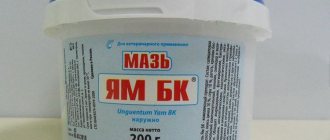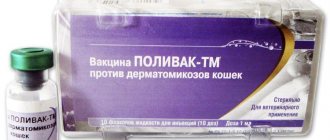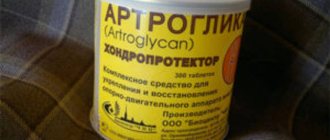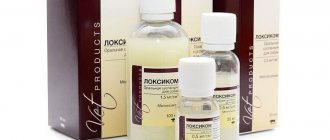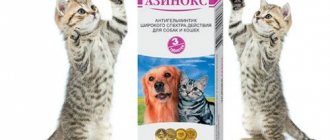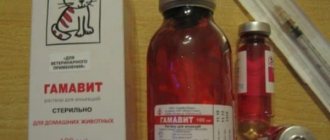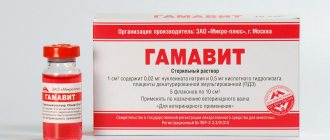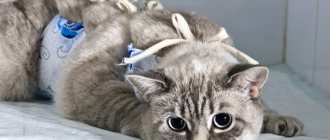Clamoxil is an antibacterial and antiviral drug that has a long-lasting effect on the body of a sick animal.
A semi-synthetic antibiotic from the penicillin category has a detrimental effect on various types of bacteria. Thanks to the use of this product during the rehabilitation period after surgical procedures in cats, the risk of inflammation and infection of open wounds is reduced. In addition, Clamoxil successfully suppresses the progression of cystitis, pulmonary pneumonia, and eliminates the formation of sepsis, trophic ulcers and metritis.
Rules of transportation and use
Clamoxyl for cats is packaged in 100 ml glass bottles, sealed with rubber stoppers and reinforced with aluminum caps on top.
The medicine should be transported in pharmaceutical packaging. It is recommended to keep the drug separately from food. The optimal temperature for preservation is from 3 to 25 degrees.
After the initial opening of the bottle, the drug can be used for 28 days, subject to the observance of antiseptic rules.
Unused drug must be disposed of according to existing requirements.
Storage conditions
The antibacterial drug "Clamoxil" should be stored and transported only in closed original packaging. The medicine should not be exposed to moisture or sunlight. The optimal air temperature for the suspension is from 3 to 25 degrees Celsius. The antibiotic storage period is 3 years from the date of production, but if the container has been opened, the shelf life is reduced to 28 days. Expired or improperly stored Clamoxil cannot be used. Small children and animals should not have access to the medication.
Storage conditions, subject to which the product remains suitable for the stated 3 years, require keeping the closed bottle in a separate place where: there is no sunlight; no humidity; the temperature is kept within 3-25C; access for children is limited. After depressurization of the bottle, the composition must be Use no later than after 4 weeks.
"Clamoxil" should be stored and transported only in tightly sealed packaging. Avoid exposing the medication to light, heat, and moisture. Do not place the medication near food. Maintain a stable temperature where the antibiotic is stored (3 to 25 degrees Celsius).
Important! Dogs are very sensitive to painkillers. They cause bleeding in the stomach cavity, and in rare cases lead to death. It is for this reason that you should avoid using Diclofenac, Indomethacin, or Ketorolac for your pet.
Limit children's access to antibiotics. Do not take the drug after the expiration date (three years). You can keep the bottle open for no longer than twenty-eight days from the moment of opening.
If the medicine has not been used within three years, it must be disposed of.
Antibiotics do not tolerate elevated temperatures, so Clamoxil is stored in a cool place at a temperature not exceeding 25 °C. Shelf life when unopened is 3 years, after opening the bottle - 1 month.
It is unacceptable to freeze or heat a bottle of suspension, as Clamoxil for cats loses its properties.
Since the drug we are describing belongs to the category of antibiotics, correct storage conditions are extremely important:
- Strict adherence to the temperature regime is required: from 3° to 25° Celsius. Do not freeze! But long-term storage of the drug at a temperature of 30° Celsius and above is even worse, since under such conditions the components of the drug begin to disintegrate into their constituent components. Often this process ends with the formation of toxic compounds.
- Another important condition is reliable isolation of the storage area from children and pets. Antibiotics are nothing to joke about, and a “falling off” liver is far from the worst possible problem.
- And again, an important nuance - the storage location is carefully isolated from direct sunlight. The fact is that UV radiation affects the components of the drug in the same way as elevated temperature (more precisely, even worse).
If all the above conditions are met, the shelf life is exactly 3 years.
pharmachologic effect
Amoxicillin, which is part of Clamoxil LA, is not active against microorganisms that produce beta-lactamases. The component disrupts the synthesis of the bacterial cell wall, stops the production of transpeptidase and carboxypeptidase enzymes, and provokes a malfunction in the osmotic balance. The process leads to the destruction of bacteria in the development phase.
The auxiliary oily element of the medication gradually releases micronized amoxicillin into the blood circulation, thereby maintaining the long-term effect of the drug.
Instructions for using Clamoxil for cats
The highest concentration of antibiotic in the blood is recorded 2 hours after the injection. Effects at a therapeutic level are observed for 48 hours. The injection can be repeated only after 48 hours. The interval between injections must be strictly observed, since a violation can cause a decrease in effectiveness.
The medication is administered intramuscularly or subcutaneously with a dosage of 1 ml per 10 kg of pet’s weight, which corresponds to 15 mg of amoxicillin per 1 kg of weight.
If an allergic reaction occurs, the administration of the drug is stopped and antihistamines and symptomatic treatment are prescribed.
The bottle should be shaken well before administration. You cannot mix Clamoxil in the same syringe with other medications.
Amoxicillin is excreted from the body in bile and urine, unchanged.
Composition of the drug
The suspension is intended for oral administration using a needle and syringe (intramuscular or subcutaneous). For small pets, the total dosage of the administered drug is not standardized. It is recommended to inject Clamoxyl into one place in a ratio of 0.1 ml of liquid composition per kilogram of the cat’s weight. If necessary, the injection is repeated after a couple of days.
The drug has antibacterial properties. Its active component amoxicillin belongs to the penicillin group and is a semi-synthetic antibiotic. The product has its bactericidal effect on:
- gram-positive microorganisms;
- gram-negative bacteria.
The way it interacts with bacterial cells is that amoxicillin inhibits cellular synthesis by breaking the peptide bonds that are needed for murein gluing.
In accordance with the instructions, Clamoxyl 500 mg is administered parenterally, bypassing the gastrointestinal tract, after which it is slowly absorbed into all tissues and organs of the animal. After two hours, the level of antibiotic in the blood reaches the maximum value and remains at the required concentration for two days.
The drug is excreted in urine and bile without changing its appearance. According to GOST, Clamoxyl is moderately dangerous.
We invite you to read: A cat with tufts on its ears like a lynx: what kind of breed?
Dmitriy. My cat Marquis was brought from the yard as a teenager of two or three months. There was no breed in him, but he never complained about his health, and we didn’t even think that we would have to see a doctor. Quite suddenly he fell ill, stopped eating and started coughing. The disease developed rapidly, and on the third day he could hardly walk; he had to urgently pack up and go to the veterinarian, who suspected pneumonia. I’m still surprised - just one injection of klamoxin brought him back to life.
Alexandra. My neighbor is an avid “cat lady”. All her animals were well-groomed, fed and were always healthy. But suddenly trouble came - the elderly cat Barsik developed a pustular skin disease, his eyes and nostrils festered - it got worse and worse. A doctor I know suggested pyoderma and recommended antibiotics, the usual ones in tablets - which are for people.
Evgeniya: “I’ve always had cats and various problems have happened, but never like with my current cat. One terrible day I noticed that the cat’s eyes and nose were festering. In general, pyoderma was diagnosed. They prescribed treatment in tablets, but such drugs did not even get inside the cat - he spat everything out with foam. Thanks to the pharmacist, I recommended Clamoxil injections. Not quickly, but the cat was cured.”
Maria: “My cat has a cold. It always seemed to me that domestic cats cannot catch a cold - the house is warm and their fur is thick. But apparently, it seemed to me that it seemed. Having learned from past experiences, I did not delay and called the veterinarian to the house. I advise everyone to do this in emergency cases, so as not to traumatize the psyche of a sick animal by moving. Clamoxil was prescribed. Helped me quite quickly and without side effects!”
The drug contains the following components:
- Amoxicillin. This is the main active ingredient, an antibiotic from the penicillin group. It is not very new (or rather, not new at all), but it is still actively used by both veterinarians and doctors.
- Aluminum stearate.
- Purified and stabilized coconut oil.
- Phenol. There is no need to worry: this substance is harmful, but its content in the medicine is negligible, and it functions as a preservative.
In appearance, the medicine is a thick, pure white or creamy white (with vigorous shaking) suspension. We draw the attention of breeders: during any long-term storage, the medicine separates into fractions, a clear liquid appears on top, and the thick part settles to the bottom. This is completely normal, and such separation is not an indicator of poor quality of the medicine.
Fortunately, the dosage of the drug is very simple - one milliliter for every 10 kg of the dog’s weight. For every kilogram of weight there should be 15 mg of amoxicillin. The volume of the drug administered at one time is not standardized. Repeated administration (if there are objective indications) is carried out exactly two days later.
It is very important to observe the frequency of administration, i.e. if the antibiotic was administered for the first time at 10 a.m., then the procedure must be repeated two days later at the same time. If this rule is not followed, the therapeutic effectiveness of the product may deteriorate significantly.
The medication is used for food poisoning in cats, as well as in the presence of bacterial diarrhea. The drug is effective against inflammation of the lungs and bronchi, and has a detrimental effect on bacteria that cause cystitis. The medicine is prescribed to eliminate purulent lesions of the skin and mucous membranes, as well as to prevent postoperative complications in pets.
Sinulox helps with various infectious diseases in cats and dogs. Ciprovet is active against gram-positive and gram-negative microorganisms. Sulf 120 is a broad-spectrum antibiotic.
Clamoxil relieves your pet from inflammatory diseases caused by bacterial infections. In recommended dosages, the drug does not have a negative effect on the cat’s immune system. However, this medication should not be used without a veterinarian's prescription. It is important to first familiarize yourself with all possible contraindications.
Indications
Clamoxil for cats is used for the following problems:
- infectious gastrointestinal diseases;
- pneumonia;
- bronchopneumonia in newborn animals,
- cystitis;
- metritis,
- necrobacteriosis;
- damage;
- abscissa;
- joint inflammation;
- navel infection;
- pathological manifestations associated with the epidermis and soft tissues.
Also to prevent infectious and inflammatory phenomena after surgery.
Advantages and disadvantages of the drug Clamoxil for cats
Positive properties of Clamoxil:
- It acts quite softly and directed;
- Treatment through injections avoids damage to the cat's stomach and liver;
- Has a rapid bactericidal effect;
- Well distributed in tissues;
- Non-toxic.
Treatment and dosage must be prescribed by a veterinarian, taking into account the individual characteristics of the cat, such as weight, age, general health. In order to relieve the load on the kidneys and liver, hepatoprotective agents are prescribed.
The disadvantages include certain negative manifestations in the pet after taking the drug:
- All biological mass after the death of bacteria is excreted from the cat’s body through the kidneys and liver, increasing the risk of chronic diseases;
- The drug is an antibiotic, and its use leads to the destruction of a large number of beneficial and necessary bacteria for the body;
- There is a factor of individual intolerance to the main component of the drug;
- Allergies associated with taking Clamoxil are possible.
An allergic reaction is expressed by:
- swelling;
- itching;
- baldness;
- rashes on the animal's skin;
- difficulty breathing;
- anaphylactic shock.
If an allergy occurs, you should urgently stop using the medication and replace it with a more gentle medication.
Release form and composition
The medicinal drug "Clamoxil La" has the trade name Clamoxyl LA and the international non-proprietary name - amoxicillin. The antibiotic is sold in the form of a suspension for injection. In the structure of "Clamoxil" the main component is amoxicillin trihydrate, and it is complemented by such auxiliary ingredients as coconut oil and aluminum salt of stearic acid.
The active substance destroys the synthesis of the bacterial cell septum, as a result of which the bacterium stops reproducing and dies. "Clamoxil" has a prolonged effect, and this is due to the oily substance in the structure. After the injection, the medicine is quickly absorbed into the bloodstream and within 2 hours it spreads throughout all the tissues and internal organs of the cat’s body. The therapeutic concentration is maintained for 2 days. Amoxicillin leaves the cat's body along with urine or bile.
Advantages and disadvantages
The drug does not harm the animal’s digestive system as it is administered parenterally.
- mild and fast healing effect;
- parenteral administration of the drug to avoid damage to the gastric and liver mucosa;
- ability to be perfectly distributed throughout tissues;
- low toxicity.
We suggest you read: Is it possible to give cats butter: butter, vegetable
The disadvantage of "Clamoxil" is considered to be an increased risk of the formation of chronic kidney and liver pathologies. This is due to the fact that the biological mass, after the death of pathogenic microorganisms, is eliminated from the cat’s body through the kidneys and liver. In addition, Clamoxyl, being an antibiotic, destroys not only pathogenic agents, but also many beneficial microorganisms. Another disadvantage of the medication is the possibility of developing an allergic reaction.
Clamoxil for cats is available in the form of a suspension in 100 ml bottles.
Intended for injection. Clamoxil contains:
- active element - 15% amoxicillin trihydrate (150 mg amoxicillin per 1 ml);
- aluminum stearate and fractionated coconut oil.
The product has a whitish or light cream color.
Advantages and disadvantages
Clamoxil is an antibacterial semisynthetic drug of the penicillin group. Its active ingredient is amoxicillin trihydrate. 1 ml of Clamoxil contains 150 mg of active substance. The composition contains additional components - aluminum stearate and coconut oil, which are necessary to give the required consistency.
In general, the release forms are not too numerous: the drug is available in the form of a suspension intended for parenteral (injection) administration. It is packaged in glass bottles (the color of the glass depends on the specific manufacturer) with a capacity of 100 ml each. The bottles are sealed with rubber stoppers and additionally protected with aluminum caps.
Each package must indicate the name of the drug, the content of the active substance in each cm³, its release date, expiration date, and production batch number. If for some reason this data is erased, blurred, or simply unreadable due to other factors, using the medicine for its intended purpose is strictly prohibited and must be disposed of. Please note that after opening the bottle, the medicine must be used for a maximum of 28 days.
Analogs
If necessary, use Amoxicillin in tablet form - weighing 0.25 and 0.5 g, produced in contour plates or glass containers. There is also a powder. It is recommended to take the tablets for 5 – 7 days, with the calculation of 1 kg of the pet’s weight per 12 mg of the drug. The effect of the tablets occurs within a few hours.
You can also replace Clamoxil for cats with other antibiotic drugs, the active substance of which is amoxicillin trihydrate, a semi-synthetic penicillin antibiotic.
Such means include:
- Sinulox (tablets and injections);
- Amoxicillin 15%;
- Amoxoyl retard;
- Sulf 120 and 480;
- Stomorgil;
- Baytril 2.5 and 5%;
- Gentamicin;
- Cobactan;
- Dorin 300 mg;
- Lincomycin 10%.
